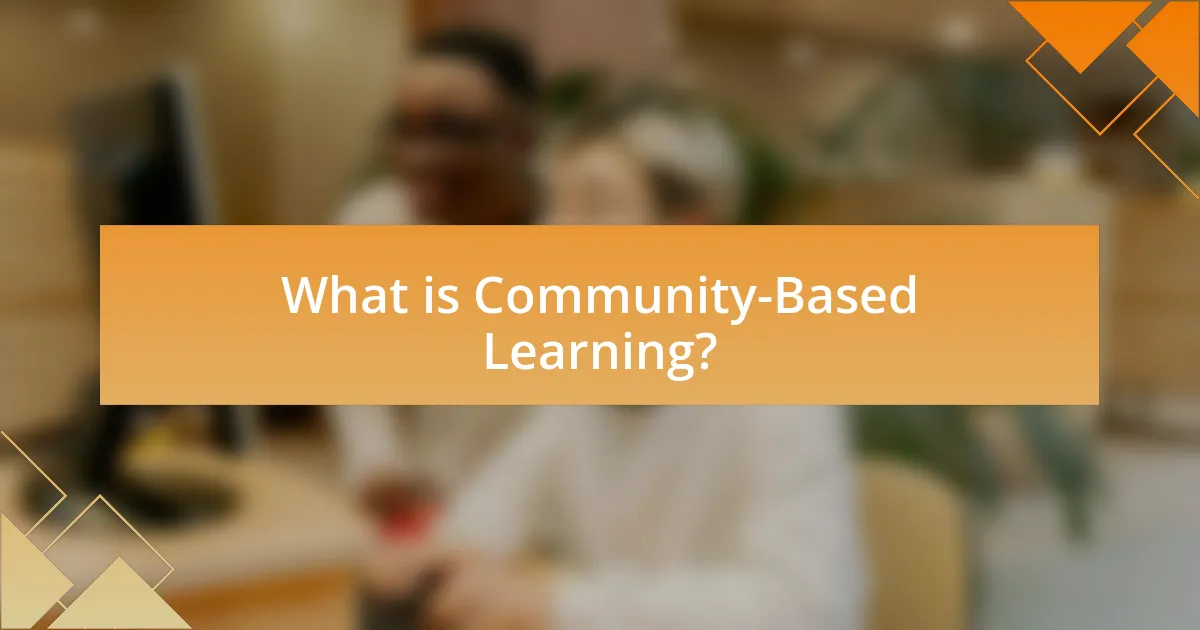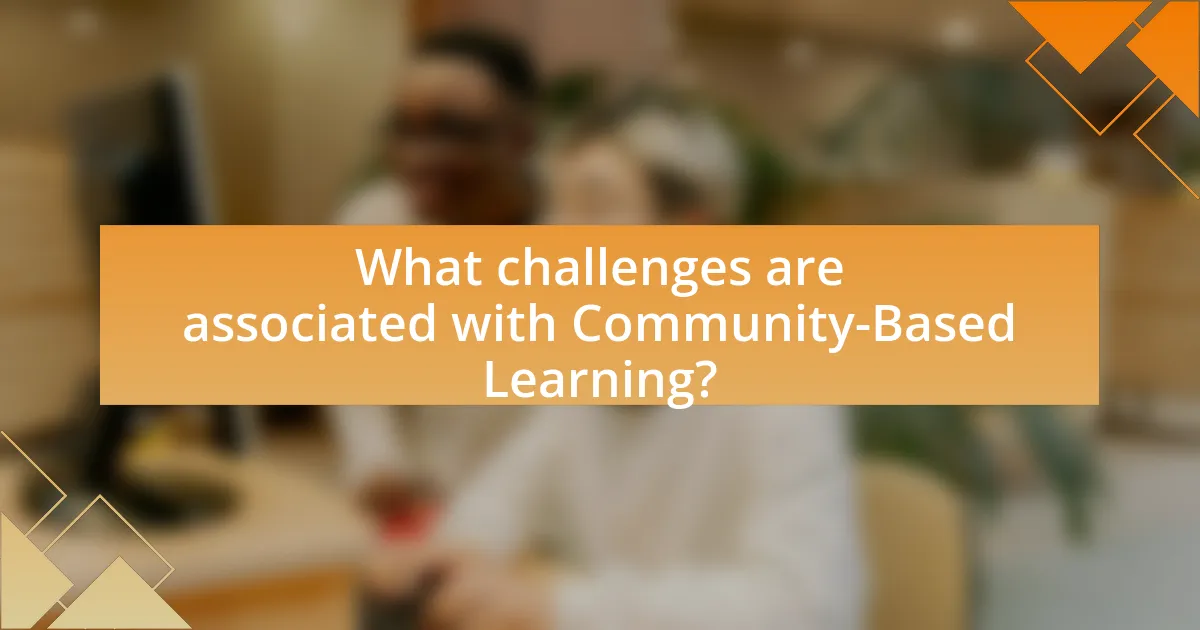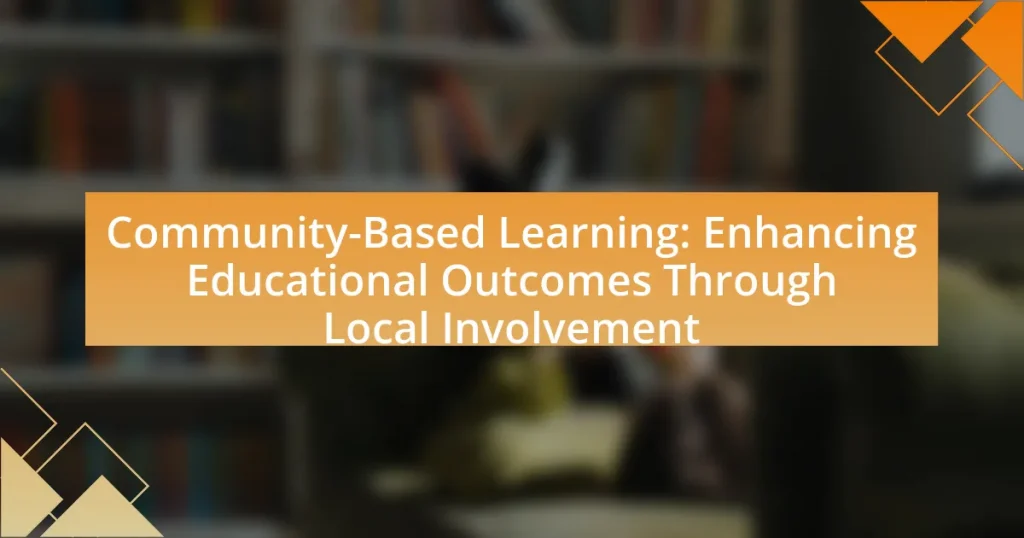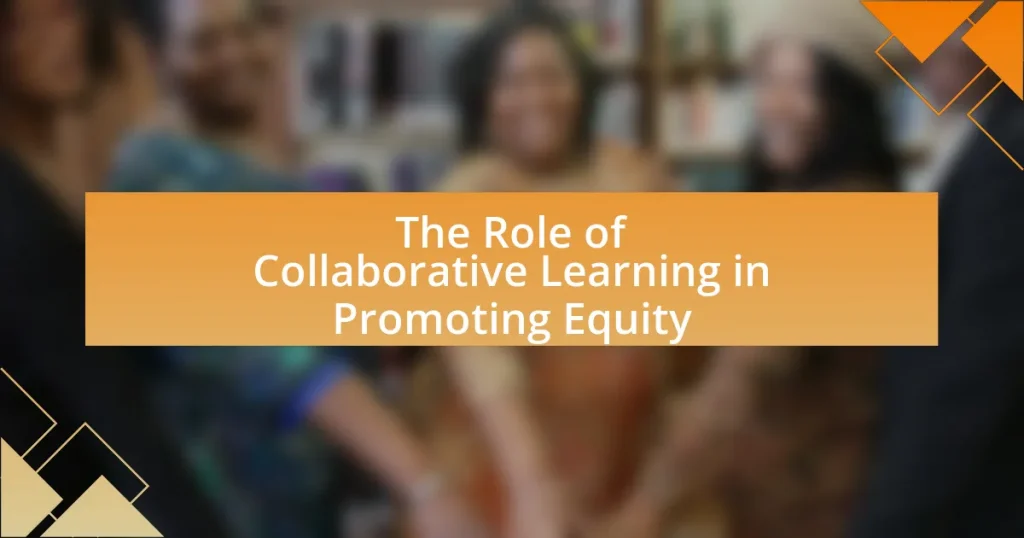Community-Based Learning (CBL) is an educational approach that combines meaningful community service with instruction and reflection, enhancing the learning experience while fostering civic responsibility. This article explores how CBL differs from traditional learning methods, emphasizing real-world engagement and collaboration with local organizations. Key principles of CBL, such as collaboration, reflection, and reciprocity, are discussed alongside its impact on student outcomes, including improved academic performance and critical thinking skills. The article also addresses the challenges associated with implementing CBL, strategies for overcoming these barriers, and the future trends shaping its role in education.

What is Community-Based Learning?
Community-Based Learning is an educational approach that integrates meaningful community service with instruction and reflection to enrich the learning experience. This method fosters civic responsibility and strengthens communities by engaging students in real-world problem-solving and collaboration with local organizations. Research indicates that students participating in community-based learning demonstrate improved academic performance, enhanced critical thinking skills, and increased civic engagement, as evidenced by studies conducted by the National Service-Learning Clearinghouse, which highlight the positive impact of such programs on student outcomes.
How does Community-Based Learning differ from traditional learning methods?
Community-Based Learning (CBL) differs from traditional learning methods primarily in its emphasis on real-world engagement and collaboration with local communities. While traditional learning often focuses on theoretical knowledge delivered in a classroom setting, CBL integrates practical experiences that involve students working directly with community members to address local issues. This approach fosters critical thinking, problem-solving skills, and social responsibility, as evidenced by studies showing that students engaged in CBL demonstrate higher levels of civic engagement and academic achievement compared to their peers in traditional settings. For instance, a study published in the Journal of Higher Education found that students participating in CBL reported enhanced learning outcomes and a greater sense of community involvement.
What are the key principles of Community-Based Learning?
The key principles of Community-Based Learning include collaboration, reflection, and reciprocity. Collaboration emphasizes partnerships between educational institutions and community organizations, fostering mutual goals and shared responsibilities. Reflection involves critical thinking about experiences and learning outcomes, allowing participants to connect theory with practice. Reciprocity highlights the importance of giving back to the community while benefiting from the learning experience, ensuring that both students and community members gain value. These principles are supported by research indicating that such approaches enhance educational outcomes and promote civic engagement.
How does Community-Based Learning engage local communities?
Community-Based Learning engages local communities by fostering collaboration between educational institutions and community organizations to address real-world issues. This approach allows students to apply their academic knowledge in practical settings, thereby enhancing their learning experience while simultaneously benefiting the community. For instance, research conducted by the American Association of Colleges and Universities indicates that students involved in community-based projects demonstrate improved critical thinking and problem-solving skills, which directly contributes to community development and social change.
Why is Community-Based Learning important for educational outcomes?
Community-Based Learning is important for educational outcomes because it fosters real-world application of knowledge, enhancing student engagement and retention. This approach allows students to connect academic content with community issues, promoting critical thinking and problem-solving skills. Research indicates that students involved in community-based projects demonstrate higher academic achievement and improved social skills, as evidenced by a study published in the “Journal of Higher Education Outreach and Engagement,” which found that 85% of participants reported increased motivation and understanding of course material.
What evidence supports the effectiveness of Community-Based Learning?
Community-Based Learning (CBL) is effective in enhancing educational outcomes, as evidenced by various studies demonstrating improved student engagement, academic performance, and civic responsibility. For instance, a meta-analysis by Billig (2000) found that students participating in CBL programs showed significant gains in academic achievement compared to their peers in traditional learning environments. Additionally, research by Eyler and Giles (1999) indicated that CBL fosters deeper learning and critical thinking skills, as students apply theoretical knowledge to real-world situations. Furthermore, a study published in the Journal of Higher Education Outreach and Engagement (2017) highlighted that CBL enhances students’ sense of community and social responsibility, leading to increased civic engagement post-graduation. These findings collectively support the effectiveness of Community-Based Learning in educational settings.
How does Community-Based Learning promote critical thinking and problem-solving skills?
Community-Based Learning promotes critical thinking and problem-solving skills by engaging students in real-world issues that require analytical reasoning and collaborative solutions. This experiential approach encourages learners to assess complex situations, consider multiple perspectives, and develop actionable strategies. Research indicates that students involved in Community-Based Learning demonstrate improved critical thinking abilities, as they must evaluate information, reflect on their experiences, and adapt their approaches based on feedback from community interactions. For instance, a study published in the Journal of Higher Education found that students participating in service-learning projects reported enhanced problem-solving skills due to the necessity of addressing genuine community needs, thereby reinforcing their capacity to think critically and creatively in practical contexts.

What are the components of Community-Based Learning?
The components of Community-Based Learning include collaboration, experiential learning, reflection, and community engagement. Collaboration involves partnerships between educational institutions and community organizations, facilitating shared goals and resources. Experiential learning emphasizes hands-on experiences that connect academic content to real-world issues, enhancing student understanding and skills. Reflection allows students to critically analyze their experiences, fostering deeper learning and personal growth. Community engagement ensures that learning activities address community needs, promoting social responsibility and civic engagement among students. These components collectively enhance educational outcomes by integrating academic learning with practical application in the community.
How do partnerships with local organizations enhance Community-Based Learning?
Partnerships with local organizations enhance Community-Based Learning by providing real-world contexts and resources that enrich educational experiences. These collaborations allow students to engage with their communities, applying theoretical knowledge in practical settings, which fosters deeper understanding and retention of information. For instance, research conducted by the National Service-Learning Clearinghouse indicates that students involved in service-learning projects demonstrate improved academic performance and civic engagement. By integrating local expertise and addressing community needs, these partnerships create a reciprocal relationship that benefits both students and the organizations involved, ultimately leading to more impactful learning outcomes.
What types of organizations typically collaborate in Community-Based Learning initiatives?
Educational institutions, non-profit organizations, government agencies, and community groups typically collaborate in Community-Based Learning initiatives. These collaborations leverage the resources and expertise of each organization to enhance educational outcomes and address local community needs. For instance, universities often partner with local non-profits to provide students with hands-on learning experiences while simultaneously benefiting the community through service projects. This synergy not only enriches the educational experience but also fosters civic engagement among students.
How can schools effectively establish these partnerships?
Schools can effectively establish partnerships by actively engaging with local organizations and stakeholders to create mutually beneficial programs. This involves identifying community needs and aligning them with educational goals, which fosters collaboration. For instance, schools can host community forums to gather input and build relationships, ensuring that partnerships are relevant and impactful. Research indicates that schools with strong community ties report improved student engagement and academic performance, highlighting the effectiveness of such partnerships in enhancing educational outcomes.
What role do students play in Community-Based Learning?
Students play a crucial role in Community-Based Learning by actively engaging with local communities to apply their academic knowledge in real-world contexts. This involvement allows students to develop practical skills, enhance their understanding of course material, and foster a sense of civic responsibility. Research indicates that students participating in community projects report higher levels of academic achievement and personal growth, as they learn to collaborate with diverse groups and address community needs effectively. For instance, a study published in the Journal of Higher Education found that students involved in service-learning initiatives demonstrated improved critical thinking and problem-solving abilities, validating the positive impact of their engagement in community-based activities.
How does student involvement impact the success of Community-Based Learning projects?
Student involvement significantly enhances the success of Community-Based Learning (CBL) projects by fostering engagement, ownership, and practical skill development. When students actively participate in CBL initiatives, they are more likely to apply theoretical knowledge to real-world situations, leading to deeper learning experiences. Research indicates that projects with high student involvement report increased satisfaction and improved academic outcomes, as students feel a sense of responsibility and connection to the community. For instance, a study by Eyler and Giles (1999) found that students engaged in service-learning reported higher levels of critical thinking and problem-solving skills compared to their peers in traditional learning environments. This evidence underscores the critical role of student involvement in driving the effectiveness and impact of CBL projects.
What skills do students develop through Community-Based Learning experiences?
Students develop critical skills such as teamwork, communication, problem-solving, and civic engagement through Community-Based Learning experiences. These skills are cultivated as students collaborate with community members on real-world projects, enhancing their ability to work effectively in diverse groups. Research indicates that students engaged in such learning environments demonstrate improved interpersonal skills and a greater sense of social responsibility, as evidenced by studies showing increased civic participation among participants in Community-Based Learning programs.

What challenges are associated with Community-Based Learning?
Community-Based Learning faces several challenges, including logistical issues, varying levels of community engagement, and assessment difficulties. Logistical issues arise from coordinating schedules between educational institutions and community partners, which can hinder effective collaboration. Varying levels of community engagement can lead to inconsistent participation, affecting the quality of the learning experience. Additionally, assessment difficulties stem from the challenge of measuring learning outcomes in a community context, as traditional evaluation methods may not adequately capture the experiential learning that occurs. These challenges can impact the overall effectiveness of Community-Based Learning initiatives.
How can educators overcome barriers to implementing Community-Based Learning?
Educators can overcome barriers to implementing Community-Based Learning by fostering strong partnerships with local organizations and communities. Establishing these connections allows educators to access resources, expertise, and support that enhance the learning experience. Research indicates that collaboration with community stakeholders can lead to increased student engagement and improved educational outcomes, as seen in programs like the University of California’s service-learning initiatives, which reported higher retention rates and academic performance among participating students. By actively involving community members in the educational process, educators can create a more relevant and impactful learning environment that addresses the specific needs and interests of students.
What are common misconceptions about Community-Based Learning?
Common misconceptions about Community-Based Learning include the belief that it is merely volunteer work, that it lacks academic rigor, and that it only benefits students without impacting the community. Community-Based Learning is not just volunteerism; it integrates community service with academic coursework, enhancing learning through real-world experiences. Research shows that students engaged in Community-Based Learning often achieve higher academic performance and develop critical thinking skills, as evidenced by a study published in the Journal of Higher Education Outreach and Engagement, which found that such programs significantly improve student engagement and learning outcomes. Additionally, Community-Based Learning fosters mutual benefits, as communities gain valuable support and resources while students gain practical skills and insights.
How can funding and resource limitations affect Community-Based Learning initiatives?
Funding and resource limitations significantly hinder Community-Based Learning initiatives by restricting access to necessary materials, training, and support. These limitations can lead to reduced program quality, fewer opportunities for student engagement, and diminished community impact. For instance, a study by the National Service-Learning Clearinghouse found that inadequate funding often results in fewer partnerships with local organizations, which are crucial for effective community engagement. Additionally, resource constraints can limit the ability to provide adequate training for educators, ultimately affecting the learning outcomes for students involved in these initiatives.
What strategies can enhance the effectiveness of Community-Based Learning?
Collaborative partnerships between educational institutions and community organizations enhance the effectiveness of Community-Based Learning. These partnerships facilitate resource sharing, provide real-world contexts for learning, and foster mutual benefits. For instance, a study by the University of California found that students engaged in community projects reported higher levels of academic achievement and civic engagement, demonstrating the positive impact of collaboration on educational outcomes. Additionally, integrating reflective practices into the learning process allows students to critically analyze their experiences, further solidifying their understanding and connection to the community.
How can reflection and assessment be integrated into Community-Based Learning?
Reflection and assessment can be integrated into Community-Based Learning by implementing structured reflection activities and formative assessments throughout the learning process. Structured reflection activities, such as journals or group discussions, encourage students to critically analyze their experiences and connect them to academic concepts, enhancing their understanding and personal growth. Formative assessments, including peer evaluations and self-assessments, provide ongoing feedback that helps students gauge their learning progress and adjust their approaches accordingly. Research indicates that integrating reflection and assessment in educational settings leads to improved student engagement and deeper learning outcomes, as evidenced by studies showing that reflective practices enhance critical thinking skills and retention of knowledge.
What best practices should educators follow when designing Community-Based Learning experiences?
Educators should prioritize collaboration with community partners when designing Community-Based Learning experiences. This collaboration ensures that the learning objectives align with community needs, fostering mutual benefit. Research indicates that partnerships enhance student engagement and learning outcomes, as evidenced by a study from the University of California, which found that students involved in community projects showed a 20% increase in academic performance compared to those who did not participate. Additionally, educators should incorporate reflective practices, allowing students to critically analyze their experiences and connect them to academic content. This approach not only deepens understanding but also promotes civic responsibility, as highlighted in the National Service-Learning Clearinghouse, which emphasizes the importance of reflection in service-learning. Lastly, flexibility in project design is crucial, enabling educators to adapt to the evolving needs of the community and the interests of the students, thereby maximizing the educational impact.
What are the future trends in Community-Based Learning?
Future trends in Community-Based Learning include increased integration of technology, a focus on interdisciplinary approaches, and enhanced partnerships with local organizations. The integration of technology, such as online platforms and digital tools, facilitates collaboration and expands access to resources, allowing learners to engage with their communities in innovative ways. Interdisciplinary approaches encourage the blending of various fields of study, fostering critical thinking and problem-solving skills among students. Additionally, partnerships with local organizations are expected to deepen, providing students with real-world experiences and enhancing the relevance of their learning. These trends are supported by research indicating that community engagement significantly improves educational outcomes and student motivation.
How is technology influencing Community-Based Learning initiatives?
Technology is significantly enhancing Community-Based Learning initiatives by facilitating communication, collaboration, and access to resources. Digital platforms enable learners to connect with local organizations and community members, fostering partnerships that enhance educational experiences. For instance, tools like online forums and social media allow for real-time interaction and feedback, which can improve project outcomes and community engagement. Additionally, technology provides access to a wealth of information and learning materials, empowering participants to conduct research and apply knowledge in practical settings. Studies have shown that integrating technology into community-based projects can lead to increased student motivation and improved learning outcomes, as evidenced by research conducted by the University of Michigan, which found that students engaged in tech-supported community projects demonstrated higher levels of academic achievement and civic involvement.
What role will Community-Based Learning play in the evolving educational landscape?
Community-Based Learning will play a crucial role in the evolving educational landscape by fostering real-world connections between students and their communities. This approach enhances student engagement and learning outcomes through experiential learning opportunities that address local needs. Research indicates that students involved in community-based projects demonstrate improved academic performance, critical thinking skills, and civic responsibility. For instance, a study by the National Service-Learning Clearinghouse found that service-learning participants had higher grades and graduation rates compared to their peers. Thus, Community-Based Learning not only enriches the educational experience but also strengthens community ties and prepares students for active citizenship.
What practical tips can educators use to implement Community-Based Learning effectively?
Educators can implement Community-Based Learning effectively by establishing strong partnerships with local organizations. These partnerships provide real-world contexts for students, enhancing engagement and learning outcomes. For instance, collaborating with local nonprofits allows students to work on community projects, fostering civic responsibility and practical skills. Additionally, integrating community issues into the curriculum helps students connect academic concepts to their surroundings, making learning more relevant. Research shows that students involved in community-based projects demonstrate improved critical thinking and problem-solving skills, as evidenced by a study published in the Journal of Experiential Education, which highlights the positive impact of experiential learning on student outcomes.



